 Monument to the first recorded baseball game at 11th and Washington streets, Hoboken, N.J. |
 The intersection has been repaved to look like a baseball diamond. |
 Monument to the first recorded baseball game at 11th and Washington streets, Hoboken, N.J. |
 The intersection has been repaved to look like a baseball diamond. |
The average factory worker in the 19th century put in 60 to 80 hours a week in order to support his family. Farm workers toiled seven days a week and were lucky to have time to attend church services on Sunday. But there was a leisure class, “gentlemen” who worked as bankers, lawyers, etc., and had time to engage in athletic activities. It was this class that formed social and athletic clubs to participate in organized sporting events such as cricket.
During the 1820s and 1830s, the game of baseball developed among these gentlemen, who took a children’s game that had been around for perhaps a hundred years and adapted it to their play as an alternative to cricket and other pastimes. Clubs in Boston, New York, Philadelphia, and other cities modified the rules to their liking. By the 1840s, the “New York game” was beginning to resemble modern baseball.
Alexander Cartwright, who belonged to a group known as the New York Base Ball Club, was eager to continue his experimenting with the rules of the game. He founded a new club, the Knickerbocker Base Ball Club, which published a set of rules in September 1845 that codified the principle that three players put out ended a team’s offensive turn, rather than continuing until everyone on a side (or all but one, as in cricket) was out. His rules also specified that a runner could not be put out by being struck with a thrown ball, a change that allowed for the introduction of a harder ball that would travel farther when hit.
At the time, New York was a rapidly growing city, and athletic clubs found themselves having to travel to find a spot with a sufficient expanse of flat, clear land on which to play. Some games were played across the East River in Brooklyn, but the Knickerbockers and New Yorks chose to cross the North River to Hoboken (then a part of North Bergen Twp) instead. There, Col. Jacob Stevens, who would later found Stevens Institute of Technology, owned an expanse known as the Elysian Fields. There, the first known game under the Cartwright rules was played 21-Oct-1845 between the New York Base Ball Club and the Brooklyn Cricket Club, which was unaccustomed to the new rules and suffered a 24-4 defeat.
Publicity for the “new game of Base Ball” started coming in 1846. A game between the Knickerbockers and New Yorks 19-Jun (won by the New Yorks, 23-1, with Cartwright umpiring) was long recognized as the first-ever game, and is memorialized in the monument depicted above. The Elysian Fields was the center of activity for the “New York game” for a quarter-century; an oft-reproduced print shows an 1865 “Grand Match for the Championship” at the Hoboken site.
By the 1870s, the development pressure that had encompassed New York overtook Hoboken (which had incorporated as a city in 1855) as well. Stevens sold the Elysian Fields for a handsome profit, and the street grid was extended through the site. A small passive and children’s park bordered by Hudson Street, the right-of-way of 10th Street, and Frank Sinatra Drive bears the name “Elysian Park”, the last vestige of Col. Stevens’ Elysian Fields.
I am not sure when the Hoboken Industry and Business Association erected their monument to baseball at the Elysian Fields at 11th and Washington. The spot may be slightly west of the original field. A plaque dedicated to early baseball was affixed to a flagpole on the grounds of a Maxwell House coffee plant, but as of 2005 the plaque has been missing for several years. That site is now a housing development, part of the vertical growth that enabled the population of the Mile Square City to grow by half between 1990 and 2010.
Meanwhile, the intersection of 11th and Washington, where the HIBA monument stands, was converted into a full-fledged baseball tribute during the renovation of all of Washington Street in 2003. The intersection was repaved in brick, with the outline of a baseball clearly visible in the center and each of the four corners being designated as a “base” with the appropriate markings H, 1, 2, 3. The above photo faces east; the four-faced clock in the traffic island was installed in 2005.